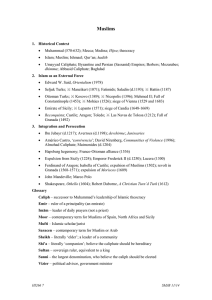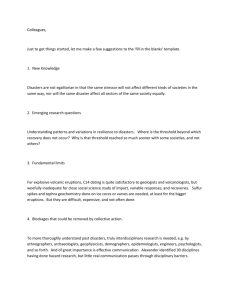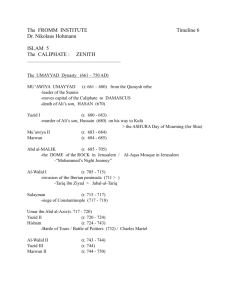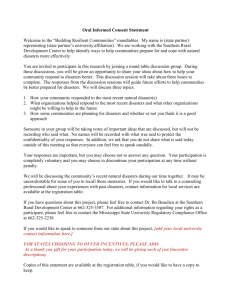The End of jihÔd St..
advertisement
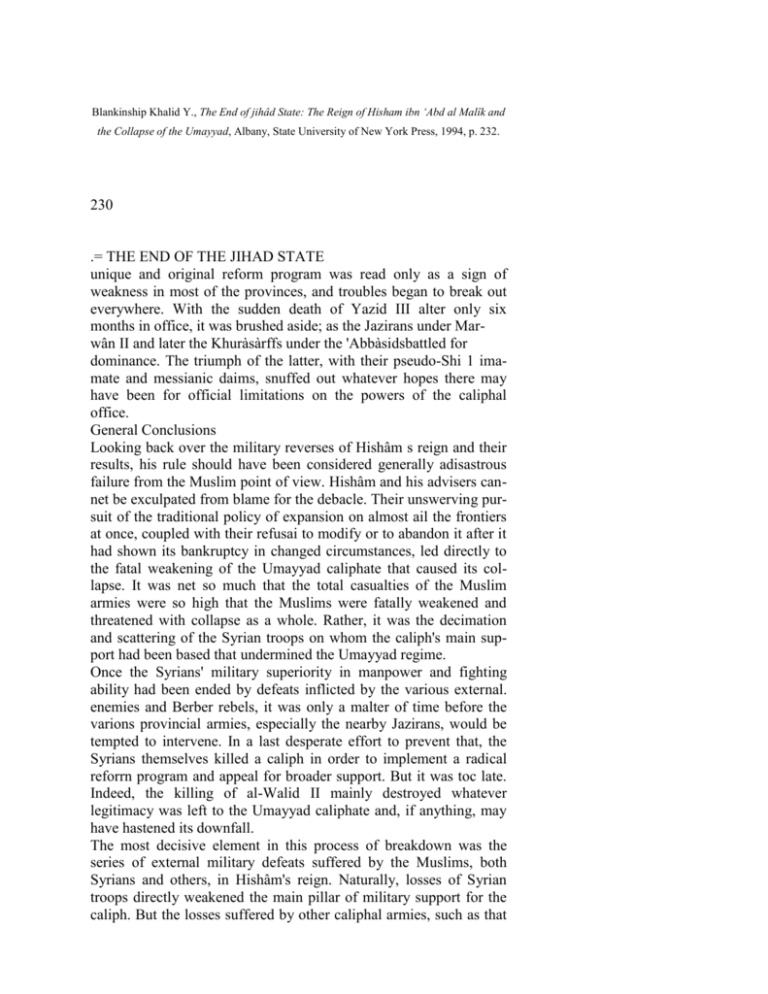
Blankinship Khalid Y., The End of jihâd State: The Reign of Hisham ibn ‘Abd al Malîk and the Collapse of the Umayyad, Albany, State University of New York Press, 1994, p. 232. 230 .= THE END OF THE JIHAD STATE unique and original reform program was read only as a sign of weakness in most of the provinces, and troubles began to break out everywhere. With the sudden death of Yazid III alter only six months in office, it was brushed aside; as the Jazirans under Marwân II and later the Khuràsàrffs under the 'Abbàsidsbattled for dominance. The triumph of the latter, with their pseudo-Shi 1 imamate and messianic daims, snuffed out whatever hopes there may have been for official limitations on the powers of the caliphal office. General Conclusions Looking back over the military reverses of Hishâm s reign and their results, his rule should have been considered generally adisastrous failure from the Muslim point of view. Hishâm and his advisers cannet be exculpated from blame for the debacle. Their unswerving pursuit of the traditional policy of expansion on almost ail the frontiers at once, coupled with their refusai to modify or to abandon it after it had shown its bankruptcy in changed circumstances, led directly to the fatal weakening of the Umayyad caliphate that caused its collapse. It was net so much that the total casualties of the Muslim armies were so high that the Muslims were fatally weakened and threatened with collapse as a whole. Rather, it was the decimation and scattering of the Syrian troops on whom the caliph's main support had been based that undermined the Umayyad regime. Once the Syrians' military superiority in manpower and fighting ability had been ended by defeats inflicted by the various external. enemies and Berber rebels, it was only a malter of time before the varions provincial armies, especially the nearby Jazirans, would be tempted to intervene. In a last desperate effort to prevent that, the Syrians themselves killed a caliph in order to implement a radical reforrn program and appeal for broader support. But it was toc late. Indeed, the killing of al-Walid II mainly destroyed whatever legitimacy was left to the Umayyad caliphate and, if anything, may have hastened its downfall. The most decisive element in this process of breakdown was the series of external military defeats suffered by the Muslims, both Syrians and others, in Hishâm's reign. Naturally, losses of Syrian troops directly weakened the main pillar of military support for the caliph. But the losses suffered by other caliphal armies, such as that of Khurâsân, aise weakened the caliph by requiring him to send more of his precious Syrians to hold the fron tiers and to spend more meney to mebilize, equip, and maintain them..S. Y ,ft e & t% n K /ers Conclusion -~ 231 Nevertheless, it had taken a very long series of reverses, lasting almost throughout Hishëm's reign, before the Syrians were weakened enough, in both numbers and resolve,.te becomevulnerable to overtl row; In fact, the Umayyad caliphate's ability to recover from its defeats was almost as spectacular as the series of defeats themselves. But the defeats continued, building up finally to the • crescendo of lossesin the Berber war. By the end of Hishàm's reign, •'the series of disasters had clearly overloaded the state's military • capacity, decimating its army and creating a financial crisis that led • te ever more severe exactions on the populace in order to pay for replacements. In particular, the army losses almost certainly would have to be made. up from new sources of recruitment to the east of • Syria, such as Iraq and Khurâsàn. Such a change in the nature of the army would lead to incalculable political consequences, as indeed happened with the rise of the'Abbâsids to power. this work, I have tried to trace the stages in this process of military breakdown with some precision. In the earliest part of Hishâm's reign, about 105-11/724-29, the wars of expansion resumed by Yazid II continued on virtually ail the frontiers, even the remote and chronically disastrous Sijistân front against the Zunbil of. Zâbulistân. This period was characterized by hard fighting punctuated by a few disasters, especially those of Muslim b. Sa-d in Transoxiana and al-Asfah b. 'Abd Allâh in Sijistân. Alter This, in 112-14/730-32, events took a turn for the worse, as the caliphate suffered at least four major defeats in the Caucasus, Transoxiana, India, and France. In the Caucasus in 112/730, a major Syrian army was annihilated for the first time. The Transoxianan disaster of 113/731 net only caused a considerable decline in the morale of the provincial army owing to the destruction of so many of its fighters, but also forced the caliph to mobilize potentially rebellious Iragis to bolster the frontier. After these concentrated disasters, a relative lull ensued from 11521/733-39. This period, nevertheless, saw many more disasters, especially on the sea in the western Mediterranean and in India, where the front totally collapsed. Possibly these new disasters did net warrant so much attention as they fell in more marginal areas and as the fosses of Syrians in them may net have been so great as those of other groups. But in the final period of Hisham's ride, 122.25/74Q..43, the number of disasters increased dramaticallY and finally threatened to destroy the Syrian army altogether. The disasters suffered by the Muslims under Hishâm have been arranged for comparison in table 4. The column entitled'Fate gives the face of the Muslim commander in the battle. Of course, the fact 232 THE END 0F THÉ JIHAD STATE that a commander survived the battie does not imply that the reverse suffered was minor. But it is dramatic how many comman-' Bers fell in battle, and especially how the number increased sharply. toward the end of Hishâm's reign. Many of the slain commanders were provincial governors, their disasters inviting comparison with those suffered by Roman consular armies in the Second Punic War. The column marked Troops' shows the predominant element among the Muslims in each battle. For nome obscure battles, these identifications are only probable. From this column, it can be seen that the Syrians burdens and disasters also increased dramatically as the reign wore on. The column entitled 'Cosses' gives the best estimate available where there is any basis for an estimate from the sources. Those battles for which numbers are given were probably among the worst disasters. Though medieval numbers must always be carefully assessed, those I have given seem most reasonable. For evidence about this and other aspects of each battle mentioned in the table, the reader should refer to the text above. Not only did the cost of these disasters in money and, especially, in lives begin to erode support for the caliph's war policy, but also the Muslim armies' continuai lack of success in the field turned the Muslim warriors and others into opponents of that policy. The caliphate's military failures under Hishâm were Idghlighted by actual territorial losses. In India, the caliphate gained nothing and was barely able to hold onto an unspecified proportion of Sind. Elsewhere, the Byzantines became more organized and posed a real threat by the end of Hishâm's reign, inflicting a major disaster on the Muslims at Akroinon in 122/740 and besting the Muslims repeatedly on the sea. For a state which derived its military success from divine approval, these were ominous signs. But worse was to corne as the Berbers dealt the caliphate one catastrophic defeat alter another in a short period, pushing the caliphate's boundaries all the way back to al-Qayrawân in Tunisia and practically cutting off Spain. Only in the Caucasus and Transoxiana was the caliphate able to triumph over ils Turkish opponents. But even these victories brought little territorial gain or booty. The inability of the Umayyad caliphate to recover from the various disasters probably helped to undermine its legitimacy. The caliphate constituted the jihhd state par excellence. Ils main reason for existence, aside from maintaining God's law, was to protect Islam and to expand the territory under its control, and its reputation was strongly bound to lis military success. Not only did military success bring greater power to Islam as well as other material benefits, but it must have seemed a sign of divine approval. Despite —1%
